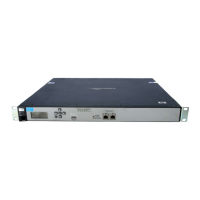Mobility traffic manager
Scenario 3: Centralized traffic on a controller with per-user traffic routing
9-28
Scenario 3: Centralized traffic on a controller
with per-user traffic routing
This scenario illustrates how to centralize the traffic from a VSC that is deployed on several
APs on different subnets and send it to different VLANs for different groups of users.
How it works
In this scenario, a single controller manages several APs deployed on different subnets. The
default VSC (named HP) is assigned to each AP and is used to provide wireless services for
users. All traffic on this VSC is tunneled to the controller by MTM, where it is egressed onto
different VLANs for different user groups.
An account profile is created for each user that define the egress VLAN for their traffic. This
profile is then associated with the user’s account.
WPA is enabled on the VSC to control user authentication. When the user logs in, the VLAN is
retrieved from the account profile and is used by MTM to route the user’s traffic to the
appropriate network via the Internet port.
Configuration overview
The following sections provide a summary of the configuration settings needed to enable
mobility support only. It is assumed that installation and configuration of all controllers and
APs so that they are fully operational on the network was performed as explained in the other
chapters in this guide.
Home network =
Network 4
Home network =
Network 3
Traffic is sent to a different
wired network based on the
home network assigned to
each user in their account
profile.
LAN port
192.168.1.1
Internet port
192.168.40.1
W
L
A
N
W
L
A
N
2
1
User B
User A
Network 2
192.168.20.0
Network 1
192.168.10.0
Network 4
192.168.40.0
Network 3
192.168.30.0
User B User A

